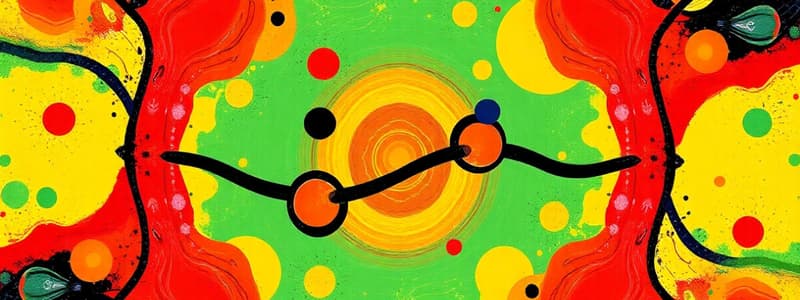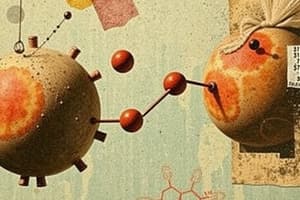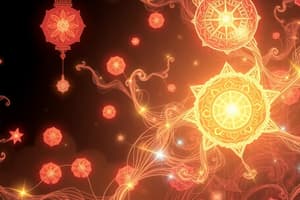Podcast
Questions and Answers
Which of the following best describes the formation of an ionic bond?
Which of the following best describes the formation of an ionic bond?
- Sharing of electrons between two metal atoms.
- Transfer of electrons from a non-metal to a metal atom.
- Transfer of electrons from a metal to a non-metal atom. (correct)
- Sharing of electrons between two non-metal atoms.
In an ionic bond, the metal atom typically becomes an anion by gaining electrons.
In an ionic bond, the metal atom typically becomes an anion by gaining electrons.
False (B)
What is the primary force of attraction that holds ions together in an ionic bond?
What is the primary force of attraction that holds ions together in an ionic bond?
Electrostatic attraction
When aluminum (Al) and sulfur (S) form an ionic compound, the formula of the resulting compound is ______.
When aluminum (Al) and sulfur (S) form an ionic compound, the formula of the resulting compound is ______.
Which of the following is a characteristic of a polar covalent bond?
Which of the following is a characteristic of a polar covalent bond?
In a nonpolar covalent bond, electrons are shared unequally between the atoms.
In a nonpolar covalent bond, electrons are shared unequally between the atoms.
Give an example of a molecule that exhibits a nonpolar covalent bond.
Give an example of a molecule that exhibits a nonpolar covalent bond.
Match the bond type with its description:
Match the bond type with its description:
Flashcards
Ionic Bond
Ionic Bond
Bond formed when a metal transfers electrons to a non-metal, creating ions that attract.
Cation
Cation
Positively charged ion formed when a metal atom loses electrons.
Anion
Anion
Negatively charged ion formed when a non-metal atom gains electrons.
Electrostatic Attraction
Electrostatic Attraction
Signup and view all the flashcards
Nonpolar Covalent Bond
Nonpolar Covalent Bond
Signup and view all the flashcards
Polar Covalent Bond
Polar Covalent Bond
Signup and view all the flashcards
Electronegativity
Electronegativity
Signup and view all the flashcards
Octet Rule
Octet Rule
Signup and view all the flashcards
Study Notes
- Ionic bonds form when a metal and a non-metal react.
- One atom transfers electrons to another in ionic bonds.
- This transfer results in cations (positive ions with more protons) and anions (negative ions with more electrons).
- Oppositely charged ions attract each other through electrostatic attraction, which forms the ionic bond.
- Ionic bonds result from the attraction between oppositely charged ions.
- Metals transfer electrons and become positive ions.
- Non-metals receive electrons and become negative ions.
- Ionic bonds connect metals and non-metals.
Ionic Bond Formation (Sodium Chloride Example)
- Electrons transfer from the metal (sodium) to the non-metal (chlorine).
- The metal atom (sodium) becomes a positive ion.
- The non-metal atom (chlorine) becomes a negative ion.
- Oppositely charged ions attract, forming the ionic bond.
Aluminum and Sulfur Ionic Bond
- Aluminum (Al) is a metal, and Sulfur (S) is a nonmetal.
- Aluminum loses three electrons to become Al³⁺.
- Sulfur gains two electrons to become S²⁻.
- Two Al³⁺ ions bond with three S²⁻ ions to form Al₂S₃ (Aluminum Sulfide).
- Opposite charges attract strongly, creating the ionic bond.
Covalent Bonds
- These are bonds where electrons are shared to satisfy the octet rule.
Polar Covalent Bonds
- Electrons are shared unequally in polar covalent bonds.
- This occurs when two covalently bonded atoms have different electronegativity.
- The atom with higher electronegativity pulls electrons more strongly.
- Unequal sharing of electrons results from this difference in electronegativity.
Nonpolar Covalent Bonds
- Electrons are shared equally in nonpolar covalent bonds.
- This happens between two atoms with the same electronegativity.
- Neither atom pulls electrons more strongly than the other.
- Equal sharing makes the bond non-polar.
Example: Two Chlorine Atoms (Cl – Cl)
- This is a nonpolar covalent bond.
- The line between them represents two electrons.
- Both chlorine atoms pull on these electrons.
- Electrons in the bond are shared equally.
Studying That Suits You
Use AI to generate personalized quizzes and flashcards to suit your learning preferences.
Description
Explore the formation of ionic bonds between metals and non-metals. Understand electron transfer, cation and anion formation, and electrostatic attraction. Examples include sodium chloride and the bond between aluminum and sulfur.




